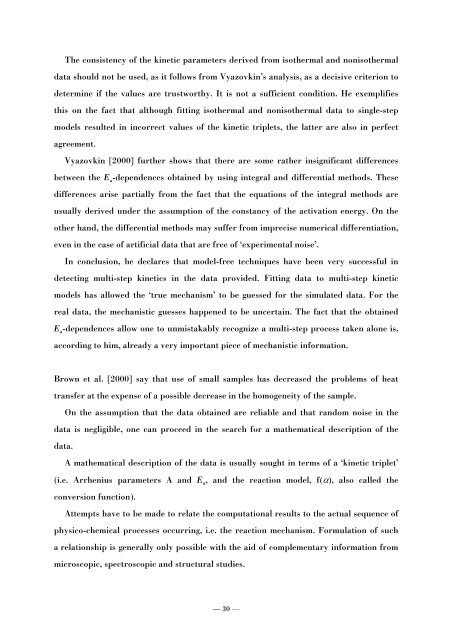PDF - Institut national polytechnique de Toulouse
PDF - Institut national polytechnique de Toulouse
PDF - Institut national polytechnique de Toulouse
You also want an ePaper? Increase the reach of your titles
YUMPU automatically turns print PDFs into web optimized ePapers that Google loves.
The consistency of the kinetic parameters <strong>de</strong>rived from isothermal and nonisothermal<br />
data should not be used, as it follows from Vyazovkin’s analysis, as a <strong>de</strong>cisive criterion to<br />
<strong>de</strong>termine if the values are trustworthy. It is not a sufficient condition. He exemplifies<br />
this on the fact that although fitting isothermal and nonisothermal data to single-step<br />
mo<strong>de</strong>ls resulted in incorrect values of the kinetic triplets, the latter are also in perfect<br />
agreement.<br />
Vyazovkin [2000] further shows that there are some rather insignificant differences<br />
between the E a -<strong>de</strong>pen<strong>de</strong>nces obtained by using integral and differential methods. These<br />
differences arise partially from the fact that the equations of the integral methods are<br />
usually <strong>de</strong>rived un<strong>de</strong>r the assumption of the constancy of the activation energy. On the<br />
other hand, the differential methods may suffer from imprecise numerical differentiation,<br />
even in the case of artificial data that are free of ‘experimental noise’.<br />
In conclusion, he <strong>de</strong>clares that mo<strong>de</strong>l-free techniques have been very successful in<br />
<strong>de</strong>tecting multi-step kinetics in the data provi<strong>de</strong>d. Fitting data to multi-step kinetic<br />
mo<strong>de</strong>ls has allowed the ‘true mechanism’ to be guessed for the simulated data. For the<br />
real data, the mechanistic guesses happened to be uncertain. The fact that the obtained<br />
E a -<strong>de</strong>pen<strong>de</strong>nces allow one to unmistakably recognize a multi-step process taken alone is,<br />
according to him, already a very important piece of mechanistic information.<br />
Brown et al. [2000] say that use of small samples has <strong>de</strong>creased the problems of heat<br />
transfer at the expense of a possible <strong>de</strong>crease in the homogeneity of the sample.<br />
On the assumption that the data obtained are reliable and that random noise in the<br />
data is negligible, one can proceed in the search for a mathematical <strong>de</strong>scription of the<br />
data.<br />
A mathematical <strong>de</strong>scription of the data is usually sought in terms of a ‘kinetic triplet’<br />
(i.e. Arrhenius parameters A and E a , and the reaction mo<strong>de</strong>l, f(α), also called the<br />
conversion function).<br />
Attempts have to be ma<strong>de</strong> to relate the computational results to the actual sequence of<br />
physico-chemical processes occurring, i.e. the reaction mechanism. Formulation of such<br />
a relationship is generally only possible with the aid of complementary information from<br />
microscopic, spectroscopic and structural studies.<br />
— 30 —
















